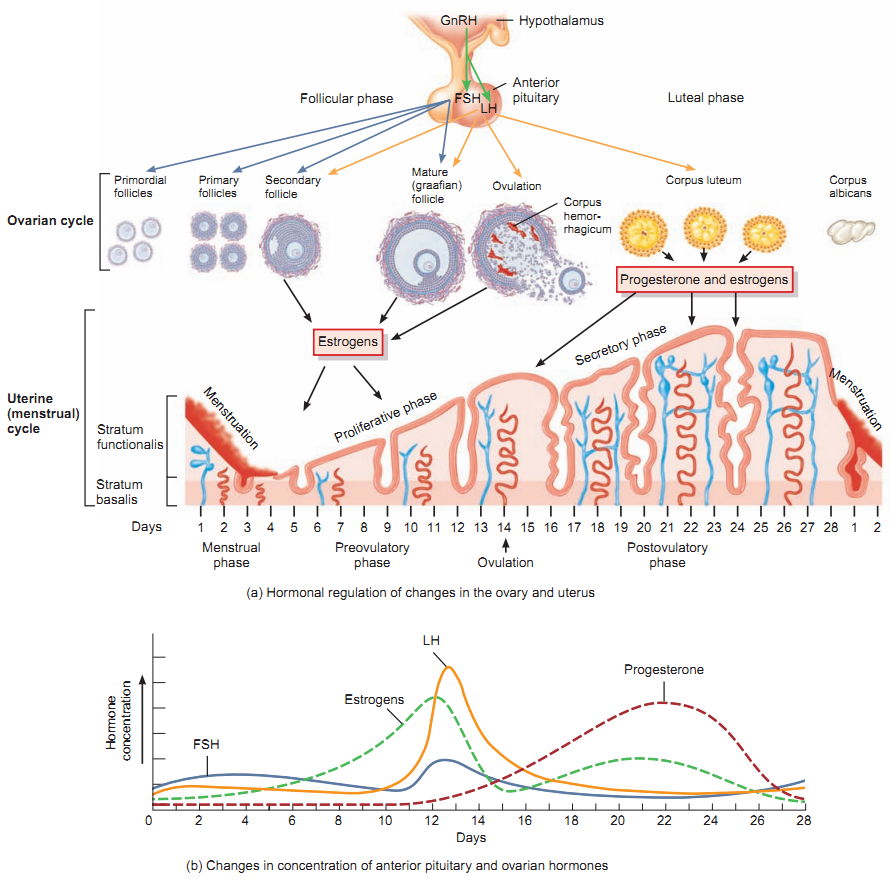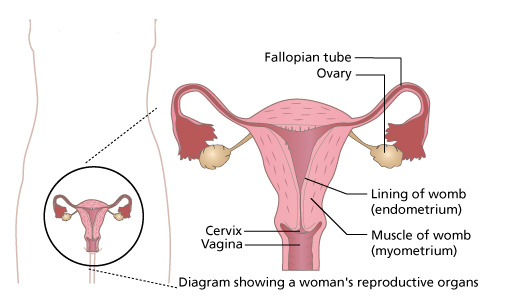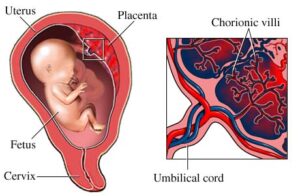The Menstrual Cycle

Most men don’t understand the menstrual cycle. If you’re a guy, don’t worry, most women don’t understand the cycle very well either but now everyone can! The reason why guys don’t understand why women get moody is because a mans testosterone level stays pretty much the same everyday. Women’s hormones levels (estrogen and progesterone) constantly rise and fall throughout the year and that not only affects their body but their mood as well. When somebody says it’s their time of the month, it’s a REAL physiological thing. Guys can’t relate to this because they don’t experience a fluctuation in their sexual hormones.
When you are a child, you suffer from childhood diseases. When you are in old age you suffer from degenerative diseases. But right now, if you are in your 20’s and 30’s you are in your optimal point of health. If a guy has to go to the doctor, they go to an internist. If a girl has to go to a doctor, almost all the time it is the gynecologist that they need to go to because that’st he most common doctor a woman is going to see.

The uterus consists of an inner lining called an endometrium where the egg is implanted, nourished by blood vessels. The thicker muscular layer is called the myometrium (myo- means muscle). The cervix widens during child birth. That cervix opens into the vagina to be the birth canal. Inside an ovary there are eggs and follicle cells. What happens during each cycle is that an ovarian follicle starts to develop in either the right or left ovary. It’s believed the ovaries alternate each month. Is it possible that an ovarian follicle might develop in both at the same time? Yes. And if that happens twins would be born but typically that doesn’t happen.
The egg cannot move on its own. Sperm can but eggs can’t. On the inside lining of the fallopian tube are cilia that move the egg toward the direction of the uterus. The fallopian tube is usually where the egg becomes fertilized. That egg lives only 3 or 4 days, that’s it. Sperm can live about 3 days. Those 3-4 days are the window of opportunity for a woman to get pregnant. There’s only 3-4 days in a month where a woman could get pregnant.
The Menstrual Cycle
The menstrual cycle is a 28-day cycle associated with the shedding of a portion of the endometrial lining of the uterus. This entire cycle is said to last 4 weeks or around 28 days. It’s not exactly 28 days, in fact it rarely is but in our idealized description it’s 4 weeks. When they decided to number this, they decided to start day 1 being the first day of menstruation because that’s easily definable and women clearly know what day that is. This shedding of the endometrial lining occurs for 3-7 days.
There’s a hormone released from the pituitary gland called Follicle Stimulating Hormone (FSH). It comes from the anterior lobe of the pituitary lobe called the adenohypophysis. Follicle Stimulating Hormone stimulates the ovarian follicle to grow and also activates the follicle cells to secrete estrogen. This FSH is secreted for about two weeks. This two week period is called the preovulatory (follicular) phase.
After two weeks, on day 14, the hormone switches from FSH to Luteinizing Hormone (LH).
Luteinizing Hormone also comes from the adenohypophysis of the pituitary gland and this is what stimulates ovulation causing the egg to pop out of the ovarian follicle. During these next two weeks (days 14-28) are known as the postovulatory (luteal) phase.
After the egg pops out, the egg moves down the fallopian tube and that’s when a woman could get pregnant. But we still have these follicle cells, and the name they give to the ovarian follicle now is the corpus luteum (corpus means body, luteum = latin for yellow because when they look at this structure it looks yellow at this stage).
Remember the ovarian follicle for the first two weeks of this cycle was secreting estrogen due to the effects of FSH. Now that ovulation has occurred due to LH, this same ovarian follicle is now called the corpus luteum and now the LH is going to make it secrete mostly progesterone (pro means prepares, gest means gestation for pregnancy) and some estrogen. These follicle cells have receptor sites for both hormones. If a woman has a heavy or light period, it is related to their progesterone hormone levels. The higher it is, the heavier the period is because progesterone makes the blood vessels thicker. These 2 postovulatory weeks are called the luteal phase because the corpus luteum secretes luteinizing hormone.
If the egg is not fertilized by day 28, the pituitary gland stops secreting LH and these follicle cells start to shrivel up and they are now called corpus albicans (albicans means white because that’s how it looks at this point) because they are dying and not secreting progesterone anymore.
This severe and drastic drop in progesterone is what causes the shedding of the endometrial lining (menstruation) to begin.
In the 19th century, menstruation was described as a womans womb crying because she didn’t get pregnant. If she had gotten pregnant, she wouldn’t be shedding those vessels because they would instead be nourishing a baby. If she’s sexually active and doesn’t have a period, she’s gonna think she’s pregnant, because her womb is not crying. She may be crying, but not her womb.
Here, this picture will help make more sense of this. Follow the text I’ve written below.
 At the top is the pituitary gland that can release FSH for a couple weeks and LH for a couple weeks. At the bottom are the cycles that represent the thickness of the endometrial lining and the hormone levels. The FSH and LH are solid lines because they come from the brain while the estrogen and progesterone are dashed lines because they are secreted by the ovarian follicle cell.
At the top is the pituitary gland that can release FSH for a couple weeks and LH for a couple weeks. At the bottom are the cycles that represent the thickness of the endometrial lining and the hormone levels. The FSH and LH are solid lines because they come from the brain while the estrogen and progesterone are dashed lines because they are secreted by the ovarian follicle cell.
For those first two weeks, when the FSH is being secreted, that causes the ovarian follicle to grow larger as you could see. As it grows larger, it secretes more and more estrogen. Then, near day 14, the spike in LH causes the egg to be popped out and LH will be secreted for the next two weeks. This spike in LH also causes the corpus luteum (notice it’s yellow) to secrete progesterone which thickens the endometrial lining and some estrogen. Estrogen causes some growth of the endometrial lining of the uterus. At the end of this cycle, the low LH production causes the ovarian follicle to shrink and the progesterone and estrogen drop and that’s what triggers menstruation.
So now to recap the three points: Day 1, 14, and 28.
Day 1 is the shedding of the endometrial lining and immediately FSH is released to get the ovarian follicle growing again. On Day 14, ovulation occurs when LH starts getting secreted from the pituitary gland. This is known as the LH Surge. LH continues to be released for the next two weeks. When the egg pops out, the ovarian follicle is now known as the CORPUS LUTEUM. The corpus luteum now releases progesterone and estrogen (because LH activates different receptor sites than FSH). There’s a window of opportunity of 3-4 days for the egg to be fertilized. There is a lot of vascularization during this time. Some raising of blood pressure occurs but more importantly, as you learned before hopefully, during the postovulatory cycle, the woman’s body temperature is half to one degree higher than normal due to the secretion of progesterone. At around Day 28, the LH stops being secreted and the follicle cells of the corpus luteum now shrivels up. The drop of the progesterone level causes a shedding of the endometrial lining and this is known as menstruation (“having a period”). This is Day 1. It’s important you know this as a chain of events because one thing causes another and there’s a connection between all of them.
Ovulation Test Kits
The most common and popular ovulation test kits involve testing urine. Remember diabetics can test if there are sugar or ketone bodies in their urine? If hormones are in your blood stream, it’s detectable in your urine. The test strips are sensitive to LH in case a woman wants to know when she’s going to ovulate. If it’s negative, there’s no LH. She will keep testing until it changes color and that means she’s just about to ovulate or has started already.
Why would a woman want to know? Either she’s trying NOT to get pregnant or she IS trying to get pregnant. In fact, it’s usually that latter reason.
During this postovulatory phase, the womans basal body temperature is raised by 1 degree. Someone could take their temperature every morning and on the morning that it is higher than before means they are ovulating. This is much cheaper than using an ovulation testing kit. This is also called the rhythm method and it is advocated by the Catholic church. Also, the catholic church can suck it, why? Cause religion is whack. (I can say what I want, this is my website, don’t like it? Go somewhere else).
What if a woman does get pregnant?
If the egg does get fertilized in the fallopian tube, the embryo implants in the uterus about one week after fertilization. Conception normally occurs in the fallopian tube, not in the uterus. This egg lives only 3-4 days; it ovulated during day 14 and can therefore be fertilized on day 15, 16, 17. Let’s pretend it gets fertilized on day 14 and this egg implants in the endometrial lining. Let’s say 1 week after fertilization occurs, it implants in the uterus. So what’s 14 plus 7? The egg implants on day 21 and this is normally before your cycle is over.
 This embryo begins secreting the hormone Human Chorionic Gonadotropin (HCG). There’s a double walled sac called the inner amniotic sac and outer chorionic sac. Chorion Frondosum is also known as the Chorionic villi (the word villi means fingerlike projection) that contain blood vessels. This is what forms the fetal portion of the placenta. The purpose of the placenta is where the exchange of nutrients and waste products occur. The chorionic villi secrete a hormone that enters mothers blood stream called the Chorionic Gonadotropin. Gonadotropin: Gonads are reproductive organs, -tropin is a greek root that means to affect, so gonadotropin affects the gonads (ovaries) of the mother (the ovaries).
This embryo begins secreting the hormone Human Chorionic Gonadotropin (HCG). There’s a double walled sac called the inner amniotic sac and outer chorionic sac. Chorion Frondosum is also known as the Chorionic villi (the word villi means fingerlike projection) that contain blood vessels. This is what forms the fetal portion of the placenta. The purpose of the placenta is where the exchange of nutrients and waste products occur. The chorionic villi secrete a hormone that enters mothers blood stream called the Chorionic Gonadotropin. Gonadotropin: Gonads are reproductive organs, -tropin is a greek root that means to affect, so gonadotropin affects the gonads (ovaries) of the mother (the ovaries).
What is HCG doing to the mother? This hormone mimics LH, which stimulates the follicle cells of the corpus luteum to secrete progesterone and estrogen. Even before the pituitary stops stimulating LH, HCG stimulates the corpus luteum. For the next 9 months it will keep telling the ovarian follicles to keep producing progesterone so there will not be a drop in progesterone so there won’t be a shedding of the endometrial lining. HCG maintains the endometrial lining there won’t be a period.
This is what happens when she tells you,”I’M LATE!” and gets that home pregnancy test kit to find out if she’s pregnant. The pregnancy test is sensitive to HCG. The only time you would have HCG in your body is if you’re pregnant. The embryo from the baby is what’s controlling this HCG. The body temperature remains elevated for the next nine months.
What if the pregnant woman starts to notice menstrual bleeding? That means she’s starting to shed the endometrial lining and if it’s significant bleeding or lining, perhaps there’s not enough progesterone. Why? Perhaps there’s not enough HCG. They might have to take pills of progesterone.
Well, I hope that helps. For more info check out this comprehensive resource about female hormones on amchara.com
And now… you’ve finished the basic primers… it’s time for you to move onto neurophysiology!






